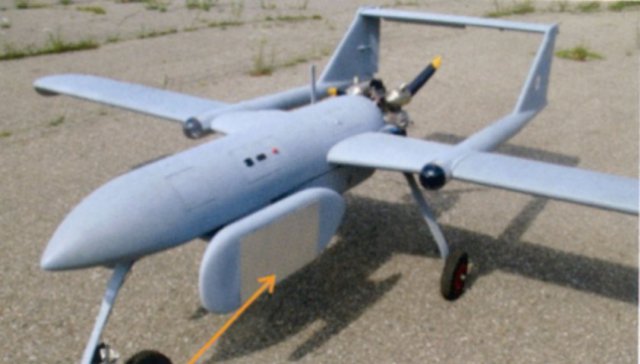 Belarus’ KB Radar Design Bureau has developed satellite communications and navigation jamming systems that can be mounted on tactical-level unmanned aerial vehicles (UAVs).
Belarus’ KB Radar Design Bureau has developed satellite communications and navigation jamming systems that can be mounted on tactical-level unmanned aerial vehicles (UAVs).
The Touman-2 has been designed to jam the downlink and transmission signals for equipment that uses Inmarsat, Thuraya, and Iridium satellite communications infrastructure, while the Touman-2.2 is intended to interfere with GPS, GLONASS, and Galileo satellite navigation systems.
The Touman-2 jammer can operate in two modes – barrage and spot – and can be used in conjunction with ground-based apparatus to enhance its effect.
A complete system is comprised of three components – a signal transmitter unit, power supply and control unit, and the cable set and auxiliary equipment. The flat-panel transmitter has been shown fitted to the side of the UAV’s fuselage.
The system utilises two-band frequency jamming covering the 1,525-1,559 MHz range for Inmarast and Thuraya systems, and 1,616-1626.5 for jamming Iridium communications; it has a stated minimum output power of 15 W across all frequencies.
According to the company, performance is optimised when the UAV-borne system operates with a system mounted on ground-based infrastructure – such a tower or mast – with the ground element providing a broad area barrage capability, while the spot mode operating on the UAV offers precise jamming of specific targets or areas.
 The Touman-2.2 features the same component structure as the Touman-2, but employs three-band frequency jamming; it also has a minimum power of 15 W; the tansmitter is a cylindrical unit.
The Touman-2.2 features the same component structure as the Touman-2, but employs three-band frequency jamming; it also has a minimum power of 15 W; the tansmitter is a cylindrical unit.
The system is optimised for jamming two GPS frequencies (L1 and L2) and two GLONASS frequencies; optionally it can suppress L5 GPS, L3 GLONASS, and L1, E5, and E6 Galileo.
For jamming GPS the Touman-2.2 works in the 1575.42 MHz (L1), 1227.6 MHz (L2), and 1176.45 MHz (L5) frequencies; for GLONASS it operates in the 1601.7 MHz (L1), 1245.8 MHz (L2), and 1202.25 MHz (L3) frequencies; while in suppressing the Galileo system it functions in 1575.42 MHz (L1), 1278.75 MHz (E6), and 1191.795 MHz (E5).
Source: IHS Jane’s 360
